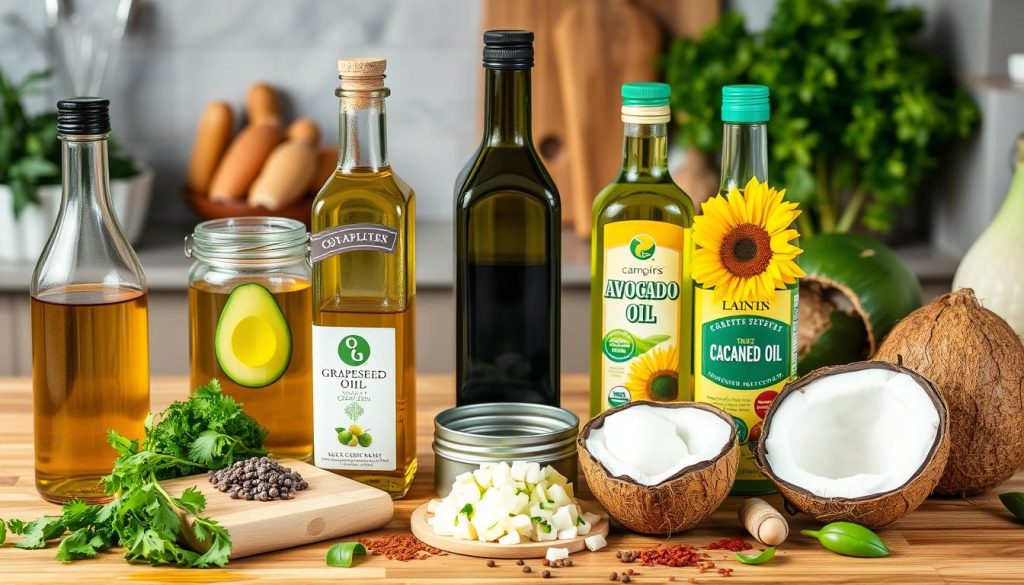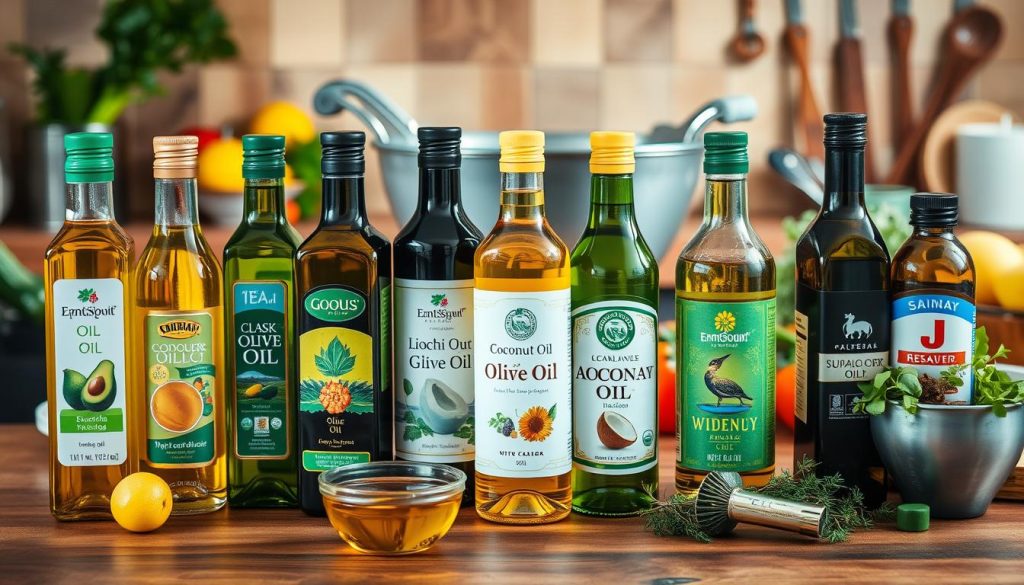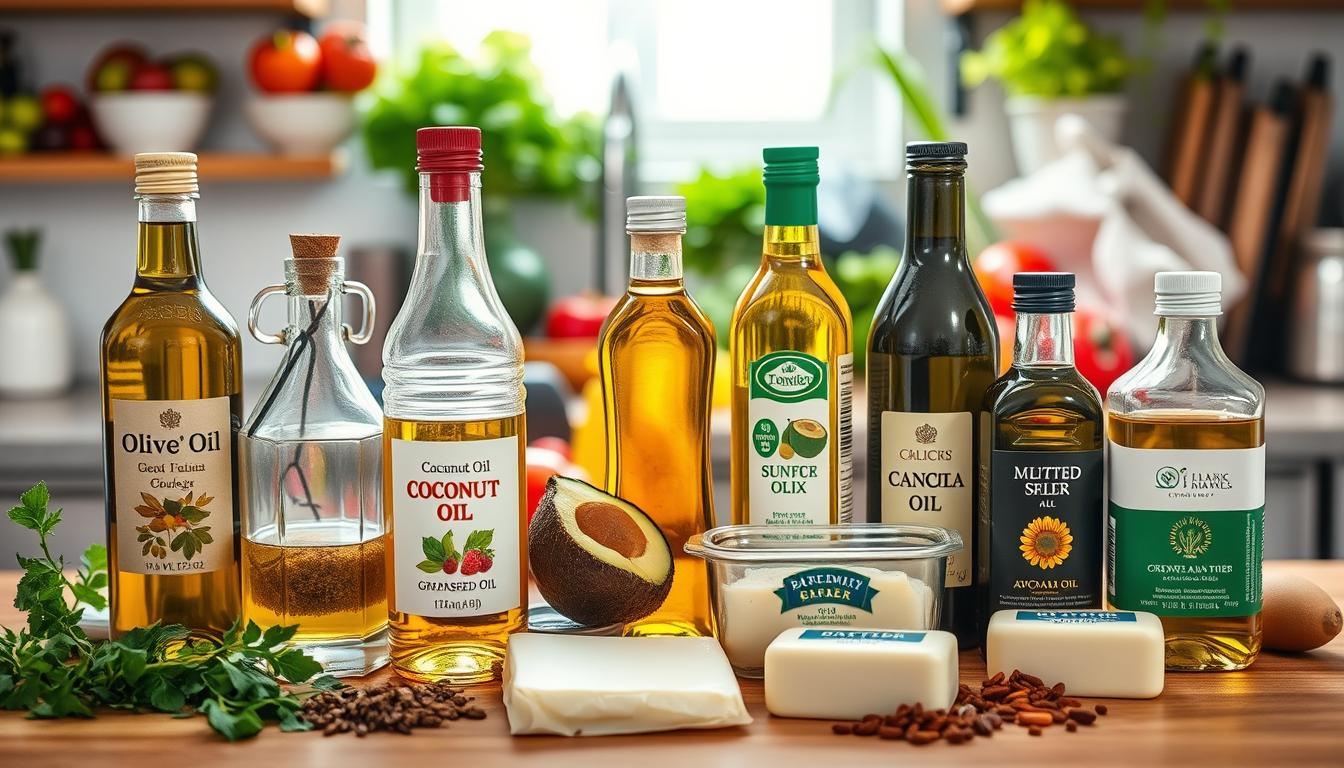Are you looking for canola oil substitutes because of health concerns? Vegetable oil production has skyrocketed in the last century. This has led to worries about their health and environmental effects.
These oils have been linked to heart disease, obesity, and harm to biodiversity. It’s crucial to find better cooking oil options.
This guide will show you the best oils for cooking and top canola oil substitutes. You’ll learn about healthier and more sustainable choices. Discover how to make better swaps in your cooking!
Understanding Canola Oil
Canola oil comes from the canola plant’s seeds. It’s known for its light taste and is very versatile in cooking. You might ask, what is canola oil? It’s made up of about 45% oil from the tiny black seeds inside the canola plant pods.
It’s a favorite because of its nutritional profile of canola oil. It has only 7% saturated fat, which is less than soybean and olive oil. This makes it popular in many recipes.
What is Canola Oil?
Canola oil is rich in healthy fats, especially monounsaturated omega-9 fats. It also has a lot of plant-based omega-3 fat. Studies show it can lower LDL cholesterol by 16.2% in about 2.5 to 13 weeks.
It also helps improve blood cholesterol and blood sugar control in Type 2 diabetes patients.
Health Concerns Associated with Canola Oil
Knowing the health risks of canola oil is important. While it has many benefits, its processing can be harsh. High heat and chemical solvents can reduce its nutritional value.
This process might create trans fats and increase omega-6 fatty acids. Too much omega-6 can lead to inflammation. This could undo the oil’s anti-inflammatory benefits.
Canola oil’s smoke point is 468˚F, good for sautéing and deep frying. But, be careful. Studies show it can help reduce abdominal fat and blood pressure in people at risk of metabolic syndrome. Knowing both the good and bad helps you use it wisely in your diet.
| Nutritional Aspect | Canola Oil | Other Oils (e.g., Olive Oil, Soybean Oil) |
|---|---|---|
| Saturated Fat Content | 7% | Higher than 7% |
| Omega-3 Fat Content | High | Lower |
| LDL Cholesterol Reduction | 16.2% Decrease | Variable |
| Smoke Point | 468˚F | Lower |
Why Consider Canola Oil Alternatives?
More people are looking for alternatives to canola oil because of health concerns. They are worried about how canola oil is made and its nutritional value. Many want oils that are less processed and better for their health.
Processing Methods and Their Impact
Canola oil is often made using high heat and chemicals. This can make it less healthy. The process includes cleaning, heating, and using chemicals to get the oil.
On the other hand, algae oil is made in a cleaner way. It has more monounsaturated fats than canola oil. This makes it a better choice for health.
Algae oil also has less saturated fat. It has only 4% compared to canola oil’s 7%. This makes algae oil more appealing for those watching their diet.
The Importance of Omega Fatty Acids
Omega fatty acids are key when choosing oil alternatives. Canola oil has more omega-6 than omega-3, which can be bad in large amounts. Omega-3s, like alpha-linolenic acid, are good for health.
Switching to oils like algae oil can be beneficial. Algae oil has a higher smoke point, making it stable for high-heat cooking. This adds to its health benefits.
| Oil Type | Monounsaturated Fat (%) | Saturated Fat (%) | Omega-3 Content (g/tablespoon) | Smoke Point (°F) |
|---|---|---|---|---|
| Canola Oil | 63 | 7 | 1.03 (Alpha-linolenic acid) | 400–475 |
| Algae Oil | 93 | High (exact g varies) | 535 |
What is a Substitute for Canola Oil Guide
Choosing the right cooking oil substitute is important. You need to think about flavor, smoke points, and nutrition. These factors help pick the best oil for your cooking.
Key Factors in Choosing an Alternative
When picking an oil to replace canola, consider these:
- Flavor: Oils taste different. Olive oil is strong, while grapeseed is mild.
- Smoke Point: For high heat, choose oils like safflower or avocado.
- Nutritional Value: Look for oils high in good fats, like avocado and olive.
Comparison of Nutritional Profiles
Knowing the nutritional differences helps you choose wisely. Here’s a quick look at some popular options:
| Oil Type | Saturated Fat (%) | Monounsaturated Fat (%) | Smoke Point (°F) |
|---|---|---|---|
| Canola Oil | 7 | 63 | 400-475 |
| Algae Oil | 93 | 535 | |
| Avocado Oil | 12 | 71 | 520 |
| Safflower Oil | 10 | 75 | 475-500 |
| Olive Oil | 14 | 73 | 375-410 |
Comparing oils helps find healthier options that fit your cooking needs. Think about your diet goals to improve your cooking.
Top Alternatives to Canola Oil
Looking for the best canola oil substitutes can make cooking healthier and tastier. These options bring unique flavors and health perks. Here are some top picks for your kitchen.
Algae Oil: The Healthiest Option
Algae oil is a top choice for healthy cooking. It’s made in a clean way, which is good for the planet. It’s full of omega-9 fatty acids, which are great for your heart.
This oil is becoming more popular for those who want to stay healthy long-term.
Grapeseed Oil: The Closest Match
Grapeseed oil tastes and cooks like canola oil, making it a great substitute. It can handle high heat up to 420°F, perfect for roasting and frying. It’s also used in dressings and marinades for a light flavor.
Olive Oil: A Heart-Healthy Choice
Olive oil is known for its heart benefits. It works well for low-heat cooking like sautéing and poaching. Adding it to your meals can help keep cholesterol levels healthy.
When choosing olive oil, watch out for scams. Pick trusted brands to get the real deal.
Avocado Oil: Perfect for High-Heat Cooking
Avocado oil is great for high-heat cooking. It can handle frying and other intense methods with a smoke point of 480°F. It’s also packed with monounsaturated fats, which are good for you.

Other Cooking Oils You Can Use
There are many cooking oils besides canola oil that work well in the kitchen. Each oil has its own special qualities. Knowing about sunflower oil, safflower oil, and coconut oil can help you choose the right one for your recipes.
Sunflower Oil: A Versatile Substitute
Sunflower oil is very versatile. It can handle high heat, making it great for frying and baking. It’s also packed with vitamin E, which is good for you.
It’s perfect for salad dressings and marinades too. It adds flavor and nutrition to your dishes.
Safflower Oil: High Smoke Point Benefits
Safflower oil has a very high smoke point, over 450°F. This makes it perfect for frying and cooking at high temperatures. It’s also good for your heart because it’s low in saturated fats.
Its neutral taste makes it great for both savory and sweet dishes. It’s a popular choice in many recipes.
Coconut Oil: Unique Flavor Profile
Coconut oil has a special flavor, often adding a sweet taste to food. It comes in unrefined and refined forms. Unrefined coconut oil is best for medium-heat cooking and baking.
Refined coconut oil has a higher smoke point, making it versatile for many uses. It’s known for enhancing flavors, especially in tropical or Asian dishes.
| Oil | Smoke Point (°F) | Health Benefits | Common Uses |
|---|---|---|---|
| Sunflower Oil | 450 | Rich in Vitamin E | Sautéing, frying, dressings |
| Safflower Oil | 450+ | Low in saturated fats | Frying, high-heat cooking |
| Coconut Oil (Unrefined) | 350 | Unique flavor, medium heat | Baking, medium-heat cooking |
| Coconut Oil (Refined) | 400 | Versatile with cleaner taste | Diverse culinary uses |
How to Substitute Canola Oil in Recipes
Replacing canola oil in recipes can change both texture and taste. By choosing oils with similar qualities, you can make direct swaps. This guide will help you smoothly switch up your cooking.
One-to-One Substitutions
Looking for oils that match canola’s taste and use is key. Here are some easy swaps:
- Applesauce: Use cup-for-cup.
- Vegetable shortening: Ideal for baked goods, keeps consistency.
- Coconut oil: Consider the sweet taste it adds.
- Unsalted butter: Melted butter can replace canola oil directly.
- Ghee or margarine: Great for flavor and texture.
These options help with your cooking and fit different diets.
Adjusting Recipes for Texture and Flavor
Switching canola oil might need some tweaks for texture and taste. Here are tips for adjusting:
- Use purees from fruits or vegetables, such as bananas or zucchini, to infuse moisture while slightly altering flavor.
- Add emulsifiers like mustard or mayo if mixing with vinegar to achieve smooth dressings.
- Consider the smoke point of your chosen substitute, especially if frying. Oils with high smoke points, like sunflower, are preferable.
Trying new things can lead to new favorites. It makes cooking more fun and creative.

Considerations When Choosing an Oil Substitute
When picking an oil substitute, think about flavor and smoke points. These factors are key to improving your cooking. The right oil can change how your food tastes and its health benefits.
Flavor Profiles: What Works Best?
Choosing the right oil means considering how it will taste with your food. Some oils have strong flavors that can make or break a dish. For example:
- Olive Oil: Has a fruity taste, especially in extra-virgin types, great for salads and Mediterranean dishes.
- Avocado Oil: Has a neutral taste with creamy notes, perfect for dressings and cooking at high heat.
- Coconut Oil: Adds a sweet, tropical flavor, often used in baking and Asian dishes.
- Ghee: Has a rich, nutty taste, ideal for Indian cooking and sautéing at high heat.
Smoke Points and Cooking Methods
The smoke points of oils are important, especially when cooking. Oils with higher smoke points can handle high heat better. Here’s a look at some common oils:
| Oil Type | Smoke Point (°F) | Flavor Profile |
|---|---|---|
| Canola Oil | 400 | Neutral |
| Olive Oil | 465 | Fruity |
| Avocado Oil | 520 | Neutral |
| Ghee | 485 | Rich/Nutty |
| Soybean Oil | 450 | Neutral |
Knowing oil smoke points helps you pick the best oil for each cooking method. Oils like avocado oil are great for frying and searing. Olive oil is better for dressings and low-heat cooking. Remember these tips to make better choices.
Conclusion
In this canola oil alternative summary, we’ve looked at healthier cooking options. These options meet different nutritional needs and tastes. Using oils like olive, avocado, and sunflower not only adds flavor but also boosts nutrition in your meals.
These choices help avoid health issues linked to canola oil. They offer fats good for your heart and overall health.
It’s key to know the differences in smoke points, flavors, and fatty acids in oils. This knowledge helps you choose the best oil for your cooking. Whether you like olive oil’s rich taste or grapeseed oil’s neutrality, picking the right oil is important.
By trying out these alternatives, you can make your cooking better. You can also meet specific dietary needs, starting a healthier cooking path.
With many cooking oils available, like coconut oil for its unique taste, you can improve your cooking. It’s about finding the best oil for you. This choice can make your meals more exciting and support your health goals.
Source Links
- https://www.zeroacre.com/blog/vegetable-oil-substitutes
- https://www.chefspencil.com/canola-oil-substitute/
- https://www.bhg.com/recipes/how-to/cooking-basics/oil-substitute/
- https://www.canolacouncil.org/about-canola/oil/
- https://ilovepokebar.ca/substitute-for-canola-oil/
- https://algaecookingclub.com/zine/canola-oil-substitutes?srsltid=AfmBOoqhYlsigcTRAjiOqd1cs-DZcSAbEHy0Jx7een3FSb4qKzQoFFa9
- https://www.medicalnewstoday.com/articles/canola
- https://www.bulletproof.com/diet-articles/healthy-eating/what-is-canola-oil/
- https://thecoconutmama.com/7-best-canola-oil-substitutes-for-any-situation/
- https://algaecookingclub.com/zine/canola-oil-substitutes?srsltid=AfmBOoqfFDinLNoWgW0BbZkFoWZC7zgzBScoQYnQrEb5in4T1oMhE4Wt
- https://distributionskatrina.com/blogs/the-katrina-blog/canola-oil-alternatives-for-cooking-baking-and-other-uses
- https://food52.com/blog/25249-best-substitutes-for-vegetable-oil?srsltid=AfmBOopnnz6k5vCJYL7N6EBDEV3xravRXpKwnS2RJ_aKsleRwIW-J3On
- https://foodbabe.com/cooking-oils/
- https://algaecookingclub.com/zine/canola-oil-substitutes?srsltid=AfmBOoqHW4knL4KZ64sQw60kIBP7Gi17ZdR_Xc602LGFlaYl4CMBsawR
- https://www.bonappetit.com/test-kitchen/ingredients/article/types-of-cooking-oil?srsltid=AfmBOoobzvbl_TD9uX9UDmMo-EhA3xA7H9T3HuIvHdFfnamsL3BnVXxQ
- https://foodal.com/knowledge/how-to/out-of-oil-substitutions/
- https://oneingredientchef.com/how-to-substitute-oil/
- https://www.bobsredmill.com/blog/baking-101/oil-substitutes-baking/
- https://www.foober.com.au/pages/canola-oil-substitute/?srsltid=AfmBOopnwFhbyPsY5gNUiDSIn85E_KlstvIMd9fh02xzhzGRHoGXnS45
- https://www.rti-inc.com/blog/vegetable-oil-vs-canola-oil/
- https://health.clevelandclinic.org/how-to-choose-and-use-healthy-cooking-oils
- https://drgooddeed.com/lifestyle/olive-oil-alternatives/
- https://www.mothersalwaysright.com/substitutes-for-canola-oil-in-baking/
